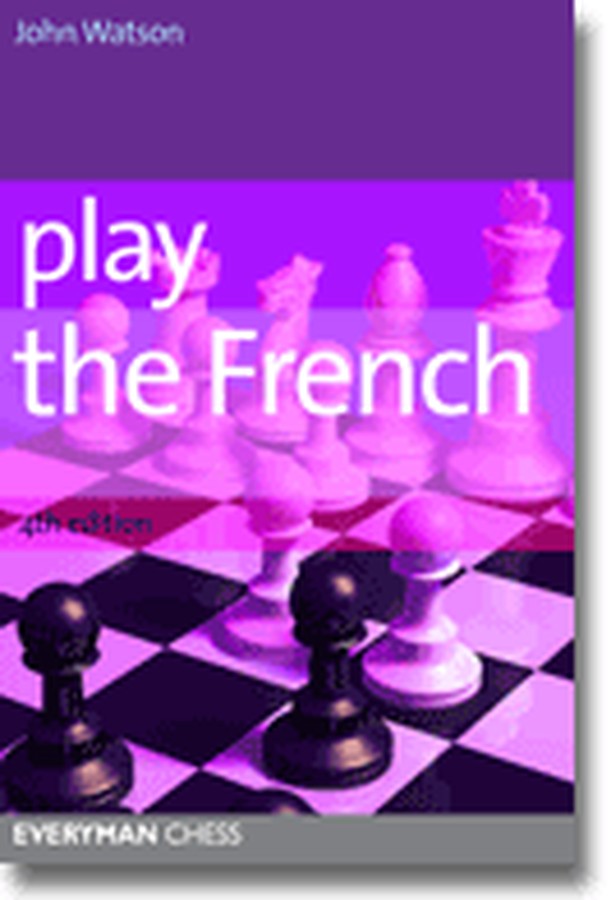| Nivå | B-D |
| Utgivelsesdato | Juli 2012 |
| Forfatter | |
| Pris | 305 NOK |
Play the French 4th edition
Fjerde(!) utgave av John Watsons smått legendariske franskbok, større og bedre enn noen gang. En repertoarbok for svart, med noen flere valgmuligheter i hovedvariantene.
Den første utgaven av Play the French kom allerede i 1984. Den fjerde kommer i det fjerde tiåret. Ingen åpningsbok i nyere tid har vel vært mer "seiglivet"!
Watsons forord
Why another edition of Play the French? Over the past two or three years, after all, numerous books on the French Defence have appeared, most of them written by very competent and insightful authors. As is the wont with modern opening works, these books usually centre their recommended variations around an instructive and/or entertaining game, without great depth but with sufficient detail to show the main branches and explain basic ideas. This is absolutely legitimate and is in fact the direction towards which I have gravitated in some of my own works. But it leaves room for a book on the French with fewer generalities and more nitty-gritty chess substance, one in which you have a better chance of finding precisely how your latest adventure with 1...e6 corresponds to a set of moves in the book, whether or not those moves are flawed. Play the French 4 is first of all a repertoire book, with a wider-than-normal choice of lines; but it is also as a reference work which tries to anticipate as many of your opponents’ logical moves as possible.
The repertoire itself is highly flexible, consisting of both mainstream variations and experimental forays. At most key junctures, the reader is offered two or more distinct variations to choose from, providing sound alternatives should some line of play prove unsatisfactory or in need of repair. Of course, a book that tries to cover so many byways will necessarily be dense and in some spots difficult to read. Therefore you may want to skim over chapters before settling in to a closer examination. But I would urge you to pay particular attention to the alternatives I’ve given to what are (temporarily) the ‘main lines’. This both prepares you to meet moves that are likely to be played, but also informs you of key ideas that may not be explicitly described elsewhere. Notice, too, that I’ve let many subvariations speak for themselves. Not that Play the French was ever excessively chatty, but I have often sacrificed verbiage to make room for specifics. I’ve also devoted much more space to original analysis, with less resort to bare game excerpts.
What’s new in this edition? It’s been nine years since Play the French 3, seemingly a lifetime given the rapidity with which theory changes in such a popular opening. I have therefore updated and re-analysed the great majority of variations, often in depth. I’ve also presented new solutions. For example, in the Advance Variation (3 e5), apart from changing some fundamental ways of playing 5...Qb6 in the main line, I have added a chapter on 5...Ìh6. Versus the Tarrasch (3 Nd2), I have returned to 3...Ìf6, not only on the basis of proven merit but also because very little, if anything, has changed in a fundamental sense in the 3...c5 lines. In the Winawer (3 Nc3 Bb4), you will see a new chapter on 6...Qa5 (which I call the ‘Portisch-Hook Variation’), and a return to the Winawer Poisoned Pawn in the main 7 Ëg4 line. There are two new chapters on the MacCutcheon Variation (3 Nc3 Nf6 4 Bg5 Bb4, replacing 4...dxe4), which is an active approach in the spirit of the Winawer; and you’ll also find a new main line in the Classical System (3 Nc3 Nf6 4 e5). These variations and similarly new approaches in lesser systems by no means indicate the failure of corresponding solutions from previous editions; on the contrary, most of them are still fully playable. But they do show how wonderfully flexible the French Defence is, and how you needn’t despair of it should a particular system fail to satisfy your needs. Finally, in terms of coverage, I have tried to pay deeper and more respectful attention to variations which are not currently in fashion and/or which have a strong following at lower levels of play.
Another change concerns the natural bias in such a book. The ‘author-advocate’ form is a difficult one; for this volume, at the harsh insistence of computer engines, I’ve spent more time modifying or rejecting my own previous suggestions than in any book that I’ve previously written. In the past, moreover, I’ve made the assumption that the reader will understand how I have tended to choose excerpts to illustrate how Black can do well (hence the use of ‘e.g.’ or ‘for example’). That is still true, but this time I have attempted to be clearer with regard to lines that are truly balanced, not by writing some sort of objective thesis but by indicating when the French player is looking to dig up chances in an equal position, rather than trying to prove any theoretical advantage. In other words, I have tried not to claim too much. In a related way, I’ve often undertaken to identify who has the easier position to play in a theoretically equal situation.
It’s difficult these days not to over-rely upon computer engines for analysis, and I’ve undoubtedly been guilty of this in some cases. But I have also found that engines are capable of systematic bias in certain pawn structures, as well as with some unusual piece configurations. So when you use a computer to analyse the material from this and other books, be a little careful. If you disagree with my or the computer’s assessment of a position (or are simply curious), don’t just set up the position and let the engine run. Instead, suggest moves for the side you think has a better position than the computer believes. Give the engine a lot of time to respond, and keep playing against the engine with the moves that you think correct, until either you change your assessment or it does. Although the machine will probably prove correct more often than not, you’ll be surprised how often it defers to your judgment.
Finally, I want to thank just a few of the many people who have made suggestions or otherwise contributed to this book, in particular John Hartman, Franz Steenbekkers, and Joachim Wintzer. Thanks also to the many contributors to the ChessPublishing Forum, not to mention its columnists Neil McDonald and Goh Wei Ming, and of course the owner and webmaster Tony Kosten. A special nod to Viktor Moskalenko for writing the most inspiring French books in recent years, easily the biggest influence on this edition. The publications Kaissiber (Stefan Bücker, editor) and Secrets of Opening Surprises (Jeroen Bosch) are remarkable for their contributions to the theory of lesser-known lines. Most importantly, thanks to the insights and hard work of my editor Jonathan Tait.
| Innbundet? | Nei |
| Type | Bok |
| Førsteutgave år | 1988 |
| Språk | Engelsk |
| Antall sider | 432 |

